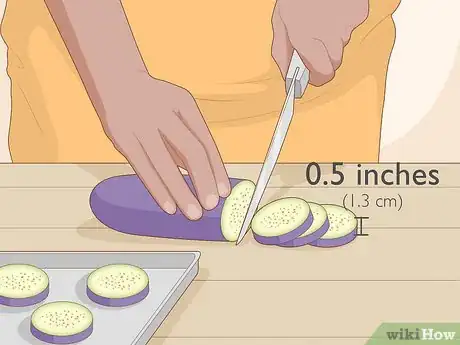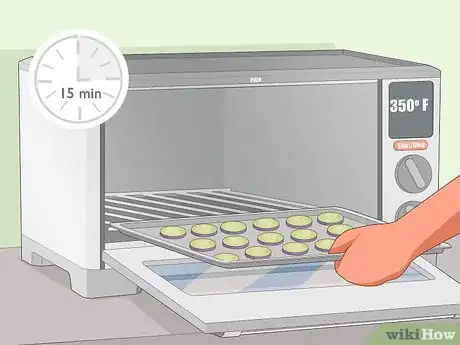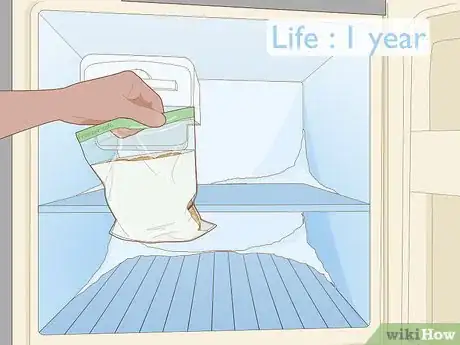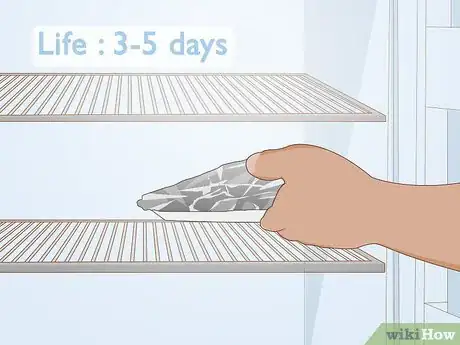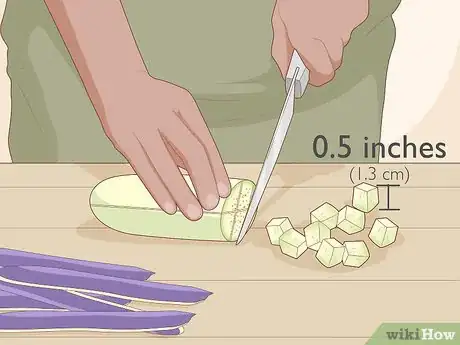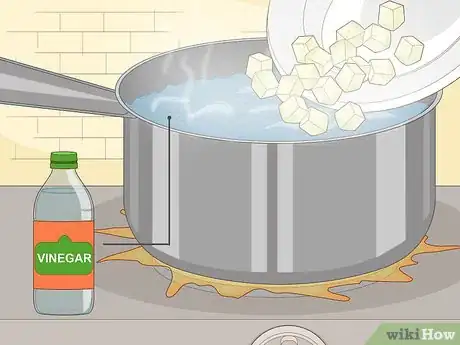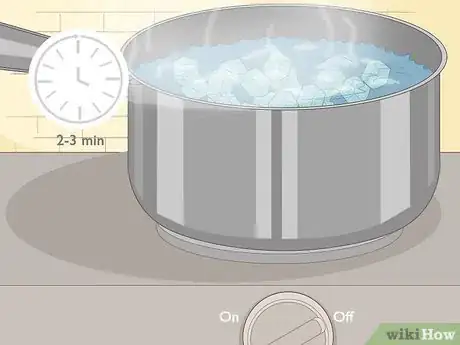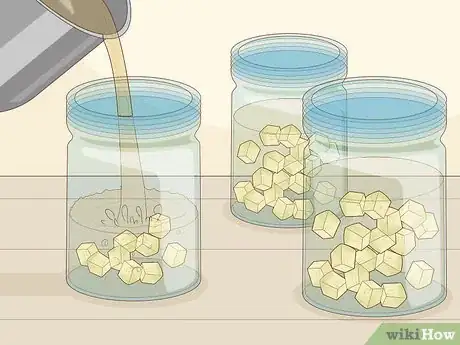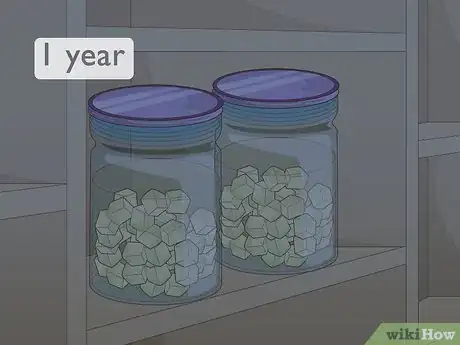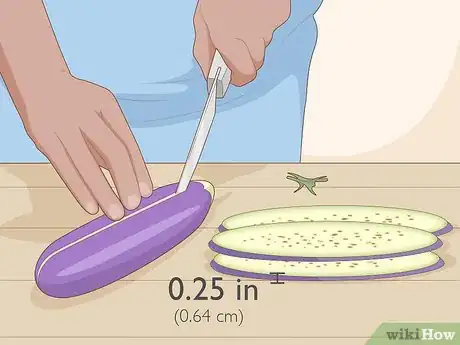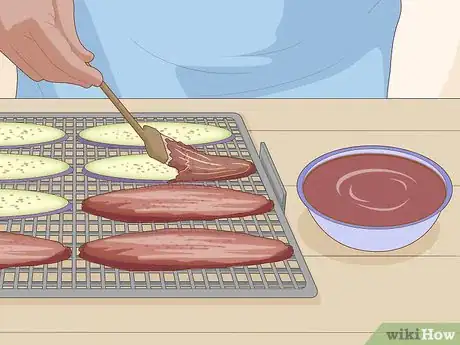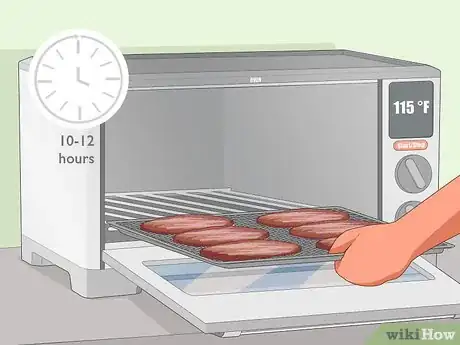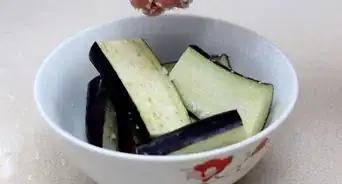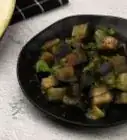This article was co-authored by wikiHow staff writer, Janice Tieperman. Janice is a professional and creative writer who has worked at wikiHow since 2019. With both a B.A. and M.A. in English from East Stroudsburg University, she has a passion for writing a wide variety of content for anyone and everyone. In her free time, you can find her working on a new crochet pattern, listening to true crime podcasts, or tackling a new creative writing project.
There are 7 references cited in this article, which can be found at the bottom of the page.
This article has been viewed 6,673 times.
Learn more...
Eggplant is delicious whether it’s served fresh or prepared in a dish. The tricky aspect of this fruit, however, is knowing how to store it properly. Thankfully, there are a variety of ways to preserve both fresh and cooked eggplant! For long-term preservation, package cooked eggplant in the freezer. If you’re only looking to store your fresh and cooked eggplant for a short while, keep it in the fridge, instead. If you’re looking for a more unconventional way to preserve your fresh eggplant, try pickling or dehydrating it!
Steps
Freezing and Refrigerating Eggplant
-
1Preheat the oven to 350 °F (177 °C) degrees. Set your oven’s temperature ahead of time so it can preheat while you’re working. Take this time to assemble your eggplants, as well as a cutting board and a sharp cutting knife. [1]
-
2Slice the eggplant into circular pieces. Use smooth, even motions to cut the eggplant into round slices. While you cut, aim for each eggplant piece to be about 0.5 inches (1.3 cm) to 0.75 inches (1.9 cm) thick. As you go, set the sliced eggplant pieces onto a greased baking sheet so they’re ready to go in the oven.[2]
- If you’d prefer, you can cut the eggplant lengthwise into thin slices.[3]
Advertisement -
3Bake the eggplant pieces for at least 15 minutes. Place the baking sheet into the preheated oven. Try to space the circles at least 0.5 inches (1.3 cm) apart, or try to prevent them from touching. Allow them to bake for 15 minutes, or until the slices are soft.[4]
- If needed, you can bake the slices for up to 20 minutes.
- Let the slices cool for 5-10 minutes before bagging them.
-
4Freeze the baked slices in bags for long term storage. Take the baked pieces of eggplant and place them snugly in freezer-safe bags. Once you have a sheet of eggplant circles laid in the bag, place a sheet of wax paper on top of them. Continue stacking until the bag is full. When stored, the eggplant will be good for about 1 year.[5]
- Depending on how much eggplant you’ve prepared, you might need several bags for storage.
-
5Refrigerate an eggplant dish for 3-5 days to preserve it for a short time. Spread a piece of foil over the top of your cooked eggplant and tuck it in around the edges of the dish. Place the food into the refrigerator after 2 hours, or else it might go bad. Be sure to eat the rest of your cooked eggplant within the week.[6]
- If the dish has cooled, you can cover it with plastic wrap as well.
- If you’re preserving fresh eggplant, place it in a plastic bag and keep it chilled in the bottom drawer of your refrigerator for up to 4 days.[7]
Pickling with Vinegar
-
1Peel and dice an eggplant into small cubes. Cut off the stem of the eggplant and use a peeler to skin the rest of the plant using long, smooth strokes. Once you’ve peeled it, start chopping the eggplant into 0.5 inches (1.3 cm) sized pieces. Repeat this process until you’ve cut up your desired amount of eggplant, but keep in mind that you may need to pickle the pieces in batches.[8]
- The pieces need to be small so they can fit into jars.
-
2Boil vinegar in a saucepan and add in the eggplant. Pour 2.5 cups (590 mL) of red wine vinegar into a medium-sized pot. Turn up the stovetop heat to the highest level, and give the vinegar a few minutes to reach a boil. Once the vinegar is scalding, dump in the pieces of eggplant.[9]
-
3Let the eggplant sit in the vinegar for 2½ minutes. Turn the stovetop heat down so that the vinegar and eggplant pieces are simmering. For around 2-3 minutes, let the eggplant soak in the heated vinegar.[10]
- At this point, the eggplant will start to absorb the sour flavor of the vinegar.
-
4Pour the vinegar and eggplant into several jars. Distribute the eggplant pieces into several glass jars for storage. Make sure that both the jar and lid are sterile before storing the vinegar and eggplant mixture. Add any extra vinegar to the top of the jars, and rap on the side to get rid of any obvious air bubbles.[11]
- To properly seal the jar, consider placing the containers of pickled eggplant into a saucepan halfway filled with boiling water. After 10 minutes, your jars should be sealed and good to go! This process is identical to how you pickle other fruits, like okra.
-
5Store the jars in a dark place for up to 1 year. Place the jars somewhere dark and cool where they won’t be exposed to any heat. If possible, find a corner of your cellar or pantry, as these locations work well for storing pickled vegetables. Let the eggplant pieces continue to soak for at least a week before you start eating them. Once prepared, the jar can be stored for around 1 year.[12]
- For a tastier dish, consider adding other herbs and spices to your pickling mixture, like mint and garlic.
Dehydrating Eggplant into Jerky
-
1Slice a halved eggplant into 0.25 in (0.64 cm) strips. Cut the unpeeled eggplant in half with a sharp knife and remove the stem. Next, cut each eggplant half into thin strips. Aim for each slice to be about 0.25 inches (0.64 cm) wide so they can dehydrate more quickly.
- If you’d prefer smaller pieces of jerky, cut the eggplant halves into 2 by 3 inches (5.1 by 7.6 cm) pieces instead of longer strips.[13]
-
2Season and marinate the strips for 2 hours. Create your own take on teriyaki jerky by dipping the eggplant strips in a watered down teriyaki sauce. If you’d prefer a different flavor palette, try a mixture of soy sauce and honey instead.[14] Place your strips in a 9 by 12 inches (23 by 30 cm) pan when you go to marinate them. Cover each strip completely before allowing the flavors to soak in for 2 hours.
- For an especially flavorful marinade, combine 4-6 minced garlic cloves; 0.5 cups (120 mL) of olive oil; 0.5 cups (120 mL) of balsamic vinegar; 0.3 cups (71 mL) of soy sauce; a ½ tsp of pepper (1g), cumin (1g), paprika (1g), oregano (0.5g); 1 tbsp (7.5g) of chili powder, 1 tsp (5.7g) of salt; and ⅛ tsp (0.2g) of cayenne pepper.
-
3Place the strips in the dehydrator for 12-16 hours. Take your marinated eggplant strips and place them on the trays in the dehydrator. After the device is securely closed, set the dehydrator to 125 °F (52 °C) and wait at least 12 hours for the strips to dry out.[15]
- Once you hit the 12 hour mark, check on the eggplant pieces periodically to see how dry they are. Ideally, the texture should be similar to traditional beef jerky.
-
4Set your strips in the oven for 10-12 hours if you don’t have a dehydrator. Place the marinated eggplant pieces on a lined baking sheet and slide them into the oven. Aim for the oven temperature to be as low as possible—115 °F (46 °C), if you can. Check on the strips once in a while to monitor their drying progress before removing them.[16]
- Once you’ve taken the strips out of the oven or dehydrator, keep the strips in an airtight container and enjoy them for up to 1 month.
Things You’ll Need
Freezing and Refrigerating Eggplant
- Cutting board
- Cutting knife
- Cooking spray
- Baking sheet
- Freezer bags
- Wax paper
Pickling with Vinegar
- Red wine vinegar
- Saucepan
- Cutting knife
- Glass jars
- Jar lids
- Water
Dehydrating Eggplant into Jerky
- Cutting knife
- Dehydrator
- Airtight container
References
- ↑ https://www.thekitchn.com/this-is-the-best-way-to-freeze-eggplant-233591
- ↑ https://www.epicurious.com/expert-advice/how-to-freeze-eggplant-article
- ↑ https://www.thekitchn.com/this-is-the-best-way-to-freeze-eggplant-233591
- ↑ https://www.thekitchn.com/this-is-the-best-way-to-freeze-eggplant-233591
- ↑ https://www.thekitchn.com/this-is-the-best-way-to-freeze-eggplant-233591
- ↑ https://stilltasty.com/fooditems/index/17142
- ↑ https://www.sharecare.com/health/food-storage-health/how-should-eggplant-be-stored
- ↑ https://www.seriouseats.com/recipes/2011/11/pickled-eggplant-with-mint-and-garlic.html
- ↑ https://www.seriouseats.com/recipes/2011/11/pickled-eggplant-with-mint-and-garlic.html
- ↑ http://www.pbs.org/food/recipes/pickled-eggplant/
- ↑ http://www.pbs.org/food/recipes/pickled-eggplant/
- ↑ https://www.seriouseats.com/recipes/2011/11/pickled-eggplant-with-mint-and-garlic.html
- ↑ https://www.thekitchn.com/how-to-make-eggplant-jerky-232877
- ↑ https://www.thekitchn.com/how-to-make-eggplant-jerky-232877
- ↑ https://www.thekitchn.com/how-to-make-eggplant-jerky-232877
- ↑ https://www.thekitchn.com/how-to-make-eggplant-jerky-232877
- ↑ https://www.thekitchn.com/this-is-the-best-way-to-freeze-eggplant-233591

